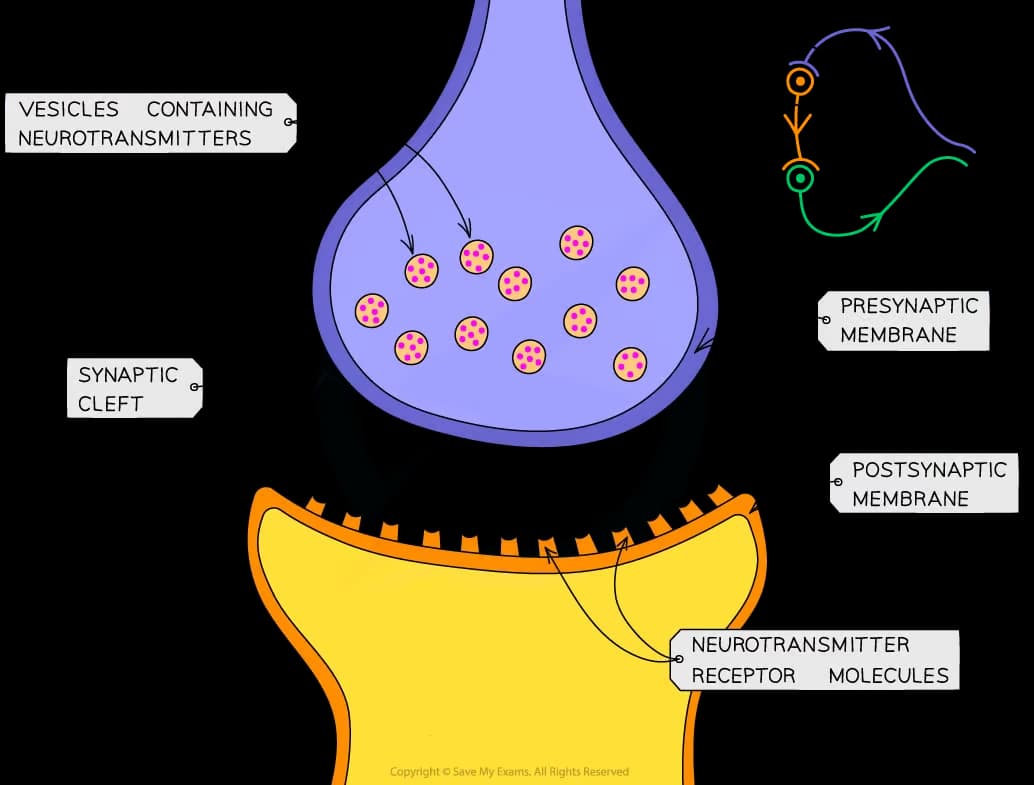Syllabus Edition
First teaching 2017
Last exams 2026
The Process of Synaptic Transmission (AQA A Level Psychology): Revision Note
Exam code: 7182
The process of synaptic transmission
The junction where two neurons meet is known as a synapse
A synapse consists of:
the presynaptic knob:
A swelling at the end of the presynaptic neuron; it contains vesicles which hold neurotransmitters
the synaptic cleft:
The space in between the axon of one neuron and the dendrites of another; where the electrical signal is turned into a chemical messenger that can be detected by the next neuron
the postsynaptic membrane
The membrane receives a signal (and binds the neurotransmitter) from the presynaptic neuron

What happens at a synapse?
Synaptic transmission involves a series of events
A signal begins as an electrical impulse (an action potential) within the presynaptic neuron
When the electrical impulse arrives at the end of the axon on the pre-synaptic knob, chemical messengers called neurotransmitters are released from structures called vesicles at the presynaptic membrane
Neurotransmitters are released into the synaptic cleft as a chemical substance from the presynaptic neuron after the action potential has occurred
Neurotransmitters diffuse across the synaptic cleft and temporarily bind with receptor sites on the postsynaptic membrane
This action stimulates the postsynaptic neuron to generate another electrical impulse (action potential) that then travels down the axon of the postsynaptic neuron
The neurotransmitter molecules are then destroyed by enzymes or recycled to prevent continued stimulation of the second neuron, which could cause repeated impulses to be sent
The re-absorbed neurotransmitter may be used again by the presynaptic neuron

Neurotransmitters
Neurotransmitters are many and varied, each having a specific function with accompanying receptor sites ready to 'catch it' e.g.
Serotonin receptor 4 (5-HT4R) plays an important role in regulating mood, particularly depression and anxiety
Dopamine receptors play an essential role in movement and the experience and anticipation of reward
dopamine receptors are located in the hippocampal dentate gyrus
Neurotransmitters are either excitatory or inhibitory
Excitatory neurotransmitters
Excitatory neurotransmitters are those which stimulate an action potential in the postsynaptic neuron
Excitatory neurotransmitters increase the neuron’s positive charge
Increasing the neuron's positive charge makes it more likely to ‘fire’
Adrenaline is an excitatory neurotransmitter
Inhibitory neurotransmitters
Inhibitory neurotransmitters are those which inhibit an action potential in the postsynaptic neuron
Inhibitory neurotransmitters increase the neuron’s negative charge
Increasing the neuron's negative charge makes it less likely to ‘fire’
Serotonin is an inhibitory neurotransmitter
Examiner Tips and Tricks
Make sure that you know each stage of what is involved in synaptic transmission. For example, you may be asked to:
'Outline the structures and processes involved in synaptic transmission'
[6 marks]
To achieve a mark in the top band for this question you would be expected to:
Communicate secure and confident knowledge of both the structures and the processes involved in synaptic transmission
You would need to include references to both presynaptic and postsynaptic processes
Your answer would need to be accurate and with a good level of detail
Your answer would have to be clear and coherent
You would be expected to use specialist terminology effectively

Unlock more, it's free!
Did this page help you?